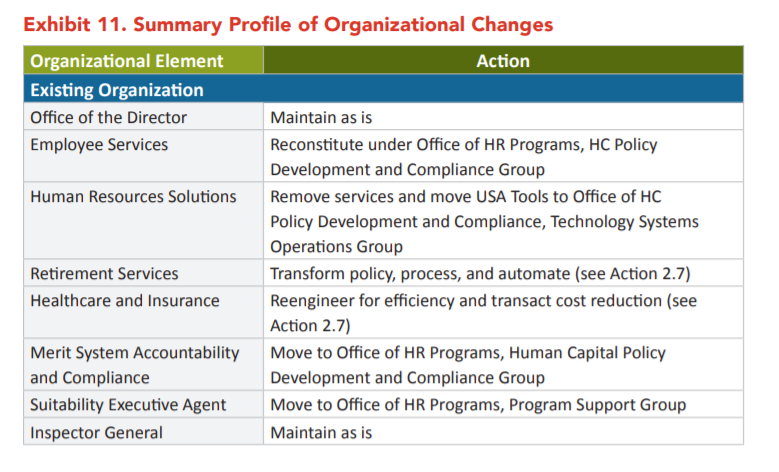Federal human capital — including OPM — need a sweeping overhaul, affinity groups say
A group of well-known good government organizations, federal employee affinity groups and private sector organizations are recommending a series of organization...
A group of good government organizations, federal employee affinity groups and private sector organizations are again making the case for an extensive, large-scale modernization of the current human capital management systems.
A new report, which was spearheaded by the Center for Organizational Excellence and the Senior Executives Association, reiterates many arguments that numerous good government groups and other organizations have, in some form or fashion, been making for years.
Current laws are outdated and fail to support a rapidly changing 21st century federal workforce. The executive branch doesn’t have the capacity or organizational bandwidth to develop or support a modern-day workforce that’s responsive to the American public.
And Congress, despite its role as an appropriator and authorizing body, hasn’t meaningfully bothered to address federal human capital management challenges through new legislation or proper oversight.
The report offers up five cases and 16 recommendations that, according to the report’s authors, would build up capacity in the executive and legislative branches to tackle persistent federal human capital challenges.
Recommendations are addressed to both Congress and the current administration. The report envisions both the executive and legislative branches taking action on these recommendations at the beginning of the next administration, with implementation spanning 10 years or longer.
“For too long federal workforce issues have been the domain of a select few champions,” the report reads. “Congress has lost sight of the value of maintaining the capability and skills of the federal workforce — the workforce that is responsible for the performance in execution of laws enacted by Congress and management of trillions of dollars on behalf of taxpayers.”
Many recommendations are familiar at this point. But others are new or offer a different twist. And many address an effort to overhaul the structure and organization of the Office of Personnel Management.
“OPM, which was created as part of the Civil Service Reform Act, was intended as the centrally-managed human capital management entity for the federal government, but for a variety of reasons, not necessarily its fault, has failed in this role,” human capital authors said.
To be clear, the report doesn’t recommend eliminating OPM or, as the Trump administration has proposed, merging portions of OPM with the General Services Administration and Office of Management and Budget.
But it does recommend a new name, a revised mission statement and an entirely new structure for the federal HR agency. And it does contemplate some of the actions the administration suggested in its merger proposal.
“As a compliance driven organization, OPM culture tends to be driven by regulations, when in reality the needs of customers — agencies, employees, hiring managers — should be the central focus,” experts said.
Complete overhaul of retirement process, technology
The report, for example, suggests sunsetting OPM’s fee-for-service HR Solutions shop. USAJobs, USA Staffing and similar OPM tools would move under a new technology services operations group within the agency. GSA would pick up administration of the Human Capital and Training (HCaTS) contract, as well as other procurement and facilities functions.
Like previous OPM directors have suggested for decades, the human capital report recommends a complete overhaul of the federal retirement process and technology. But the authors also contemplate whether retirement services should move out of OPM.
“OPM could determine and propose if this functional area would best be executed within OPM, from another federal agency, or outsourced,” the report reads. “If it is determined that outside execution is more effective, OPM should maintain policy oversight and [human capital] data ownership and control.”
OPM should also reassess its healthcare and insurance function to determine whether benefits administration can be outsourced, according to the human capital authors. Government already does this with its federal dental and vision program.
“The nation’s largest employers, such as Walmart, outsource their benefits administration, as do most private-sector organizations,” the report reads. “Once re-engineering is complete, service level agreement and transactional cost ratios should be established. OPM could then explore if it is an appropriate candidate for outsourcing.
To bring some consistency to OPM, the agency’s director should serve for a longer term, either five or eight years instead of the current four, human capital authors said.
Few OPM directors in recent years have served a full four-year term, as the agency has been plagued with near constant turnover during the Obama and Trump administrations. On Monday, the president nominated a fourth person in nearly as many years to lead OPM.
The report also recommends reorganizing OPM into four main offices to include strategic programs, human resources programs, federal employee benefits, and agency operations. A career deputy director would lead each new OPM office.

Beyond the four new offices and longer term for the OPM director, human capital authors recommend the creation of a Human Capital Business Board, modeled after the Defense Business Board.
Six “credible and non-conflicted experts in large scale government transformation, human capital, and related systems” would sit on the board and provide independent advice to the OPM director, according to the report
The authors also recommend strengthening the role of the Chief Human Capital Officers Council. The council should self-govern and serve as more of an advisory group to the OPM director, the report said.
OPM, the CHCO Council and the Human Capital Business Board should, together with Congress, develop more strategic visions for federal hiring, talent development reskilling and other workforce initiatives. Many human capital activities are too expensive and inefficient compared to the private sector, the authors argue.

The report comes as the National Academy of Public Administration is currently conducting its own, congressionally-mandated review of OPM and its statutory functions, which SEA and the Center for Organizational Excellence plainly acknowledge.
“While efficiencies can certainly be quantified and realized in OPM, we recommend that Congress take no action until after the NDAA-directed NAPA study is complete, but more importantly, until a clear plan for improving the efficiency, effectiveness and credibility of OPM and government-wide human capital management is complete,” the report reads. “It would make no sense to consider moving OPM without effecting a significant transformation first, so that a ‘lift and shift’ does not occur without significant strategic benefit, or to just realize a false sense of ‘job complete’ after the move.”
NAPA and its CEO, Terry Gerton, are listed as contributors or stakeholders involved in this human capital report, as well as the National Active and Retired Federal Employees Association, Society of Human Resources Management, Association of Government Accountants, Grant Thornton, the IBM Center for the Business of Government and several former agency officials.
Both the American Federation of Government Employees and National Treasury Employees Union have policy directors listed as contributors. Stakeholders didn’t see all drafts and iterations of the human capital report.
Copyright © 2024 Federal News Network. All rights reserved. This website is not intended for users located within the European Economic Area.
Nicole Ogrysko is a reporter for Federal News Network focusing on the federal workforce and federal pay and benefits.
Follow @nogryskoWFED







